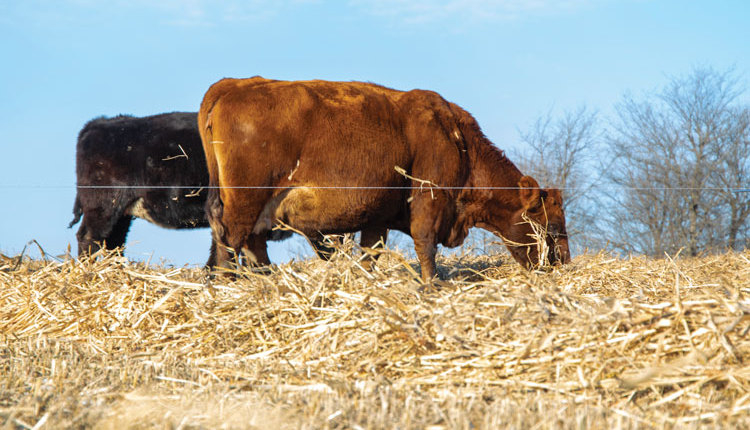The author is a rancher, author, speaker, and consultant with over 40 years of experience in grazing management research, outreach, and practice. He has lived and grazed livestock in hot, humid Missouri and cold, dry Idaho.

With the high cost of making or buying hay in recent years, I have been getting a lot of inquiries regarding swath grazing as an alternative to feeding baled hay. Swath grazing entails mowing the hay crop or pasture and leaving it in a windrow for grazing later in the winter. It is a proven cost-saving strategy that works well in some parts of the U.S.
The first consideration for feasibility is your autumn rainfall pattern. If you have regular late summer or fall rains and lingering warm temperatures, swath grazing isn’t likely to work for you. A dry fall with early frosts is the best weather pattern for successful swath grazing. If a late cut of hay rots or molds in the windrow rather than curing, that is a clear indicator swath grazing will not work in your environment.
Swath grazing still requires the forage be swathed and, in some cases, raked. What you save is the cost of baling, stacking the hay, and then hauling it back out for feeding. That usually amounts to $30 to $50 per ton of forage fed. If you don’t need to rake a couple of windrows together to make a larger windrow, there can be additional cost savings.
Many options available
Almost any forage crop can be swathed to preserve forage quality deeper into winter and allow better grazing access in deep snow environments. When we have swath grazed alfalfa, we leave the last crop standing until the first killing frosts occur. The frosts put alfalfa into dormancy and then we get the crop swathed before significant leaf loss occurs. In our central Idaho environment, we can sometimes get snowfall on the swaths shortly after swathing, which helps preserve forage quality even better than an open winter provides.
We have some clients who swath their grassy meadows. These are typically either flood irrigated or naturally sub-irrigated. All growth has usually occurred by the end of July or early August, so they swath in midsummer to better preserve feed quality. Initially, many ranchers are concerned about the swaths smothering the grass underneath them. However, in a dry climate, the grass has gone dormant as soon as available water has been depleted. The dormant grasses are not subject to smothering.
Annual crops are another popular forage for swath grazing. Annual crops are often much higher yielding than are perennials like alfalfa or meadow grasses. Cool-season mixtures like triticale-barley-oats-vetch-winter peas can create huge swaths of high-quality forage. We have harvested 290 animal unit days (AUD) per acre or almost 4 tons per acre of dry matter from a barley-oats-winter pea mixture. Annual mixtures featuring a high percentage of brassicas like turnips or kale do not swath as well as grasses and legumes due to their high initial moisture content.
Summer annuals can also be swathed to provide winter feed. Everything from corn to crabgrass can be swathed. I have not personally done the warm-season annuals but have heard reports of 300 to 400 AUD per acre swath grazed as sorghum-sudangrass and vetch or other annual legumes. Warm-season swaths can be a low-cost method for overwintering pregnant cows or even yearlings.
Move daily
To get the most from your investment in seeding and swathing, all swath grazing should be done with time-controlled grazing. When we were grazing alfalfa swaths on the ranch in Idaho several years ago, I would move the fence every day when I was at home. If I had to travel away, I would leave the fields set up for three-day grazes so my wife wouldn’t have to move fence every day. When I returned home, the additional bedding waste in the swaths was visible and the cows were noticeably less content compared to when they were on daily moves.
I found I had to allocate four days’ worth of swaths to keep the cows at the same level of rumen fill and contentment for a three-day stay as three single-day strips provided when I was at home. In other words, grazing with daily moves provided about 33% more grazing days over the dormant season compared to moving every three days. Set stocking on swaths provides only about 50% of the AUD per acre that controlled grazing does. Growing the crop and swathing costs the same, so lax grazing costs roughly almost twice as much per day as what controlled grazing can provide.
We were running about 300 cows that winter on swaths. It took me about an hour to get out to the pasture and move the electric fence each day. If I paid myself $30 per hour to go out and move the fence, the added cost for strip grazing the swathed forage was 10 cents per cow per day. Considering at that time hay feeding cost more than $1 more per cow per day, strip grazing was a low-cost tool for stretching the winter feed supply.
This article appeared in the November 2023 issue of Hay & Forage Grower on page 14.
Not a subscriber? Click to get the print magazine.

